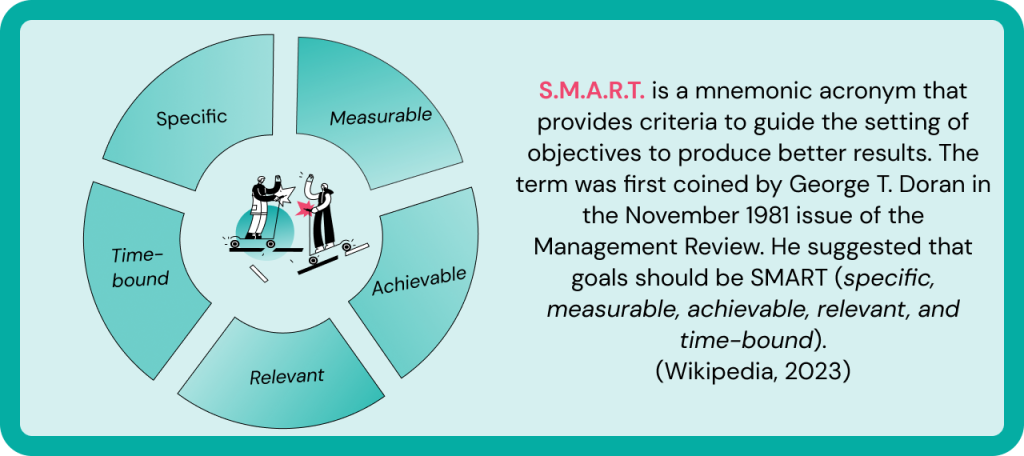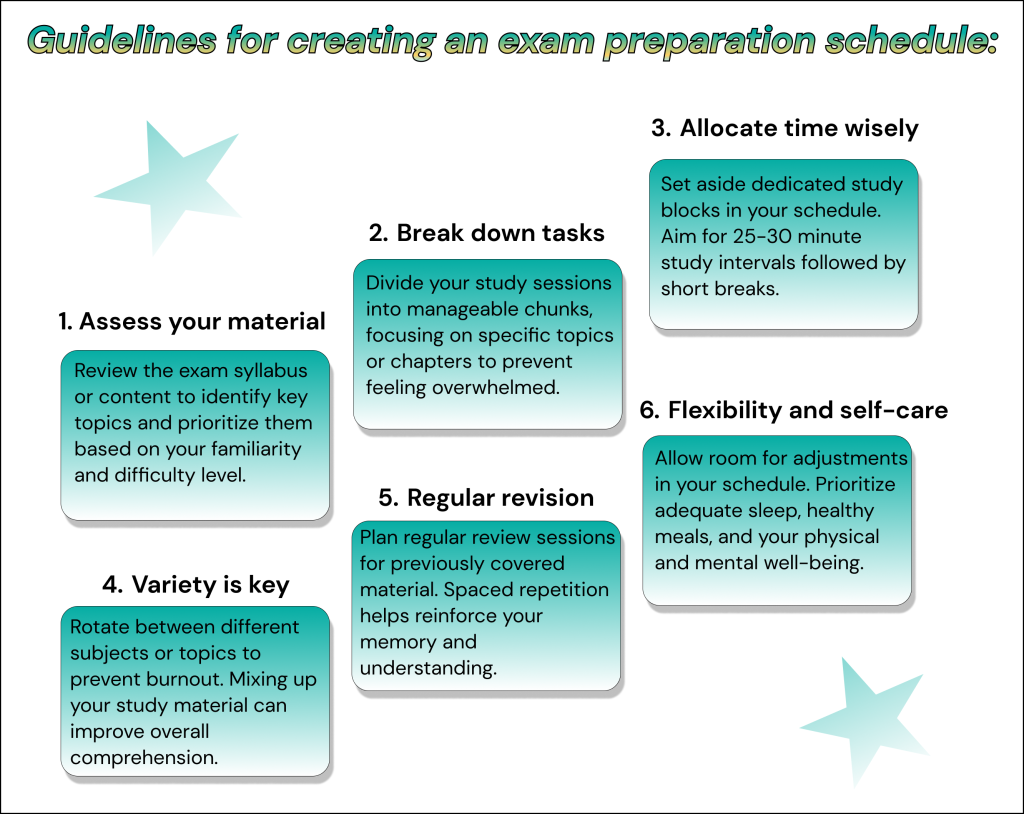A study plan may not seem like the most exciting thing in the world, but believe us when we say it is a game changer. Imagine having a personal roadmap that leads you through the jungle of assignments, readings, and exams. That’s what an effectively structured study schedule is all about – this is your academic GPS. And guess what? It’s not just about hitting the books all the time; it’s also about finding that sweet spot between your school stuff and your personal life. It helps you juggle your academic commitments and your hangouts with friends, gym time, or Netflix binging. Because, let’s be real, no one wants to be that student who only knows the inside of the library.
So, get ready to discover the secrets of a perfect study schedule to balance your academic journey and have a life worth living.
What Are Your Goals and Priorities?
Start by thinking about what you want to achieve. Do you want to ace that calculus test next week? Or maybe you’re aiming for a spot on the Dean’s List by the end of the semester. Whatever it is, knowing your goals is like having a treasure map for your education journey.
Short-run objectives are those little checkpoints that keep you on track when you plan to study. They could be acing quizzes, finishing assignments early, or nailing presentations. Long-term goals, on the other hand, are the big kahunas, like graduating with honors or landing in your desired graduate school.
However, life isn’t just about hitting the books. You’ve got passions and hobbies outside of class, right? Maybe you’re into soccer, drama club, or playing the guitar. And let’s not forget those family dinners and catching up with friends. When creating a study schedule, you’ve got to factor in all these other commitments, too. It’s like putting together a puzzle – your academic goals and your personal life need to fit together just right.
“Before you start scribbling down study hours, take a moment to think about your goals, both big and small. Knowing what you’re aiming for and understanding your commitments can guarantee your study schedule becomes your sidekick, not a stress-builder.”
Xiu Zhang, an international student in the USA
Define Your Learning Style
Do you know how some people remember things better when they see pictures or diagrams? That’s the visual learner in action. Others are all ears – they soak up information when someone explains it. That’s the auditory learner. And then we’ve got the hands-on folks – the kinesthetic learners who learn by doing, touching, and moving around.
Identifying your learning style is similar to discovering your superhero power. Are you the Flash who learns by moving? Or maybe you’re more like Spider-Man, absorbing info when you see it? Once you know your style, you can tweak your study schedule to match it.
Visual learners can create colorful charts and diagrams to help information stand out. Auditory learners could record their notes and listen on the go. And kinesthetic learners – well, you could try studying while standing or walking around. (Just make sure you don’t bump into anything!)
So, when you’re setting up your schedule, think about your learning style. It’s like tailoring a suit – it has to fit you perfectly to be effective. Studying becomes way more fun when it’s done your way.
Stick to the “SMART” Objectives
SMART goals are like a roadmap to success. The first word is an acronym for Specific, Measurable, Achievable, Relevant, and Time-limited. Let’s break it down.
- Specific. Instead of saying, “I want to do well in math,” you’d say, “I want to score an A on my math quiz next week.”
- Measurable. This means you can track your progress. So, instead of saying, “I want to read more,” you could say, “I want to read a chapter of my history book every day.”
- Achievable. No aiming for the moon – keep it realistic. If you’re not a morning person, setting a goal to study at 5 AM might be a stretch.
- Relevant. Your goal should be consistent with the “bigger picture.” If you’re studying art, becoming a pro at the theory of relativity might not be relevant.
- Time-limited. Set a time boundary for your objective. It adds that extra push. Like, “I want to finish my chemistry homework by 7 PM today.”
Big objectives might be quite daunting. That’s why we break them down into baby steps. Imagine trying to eat a whole pizza in one go – not fun, right? But if you slice it up, it’s suddenly manageable. The same goes for studying. Break down huge tasks into smaller bits. You’ll be surprised at how much easier creating a study schedule becomes.
Incorporate Breaks and Rest
You might think studying non-stop is the way to go, but take it from us – breaks are like little bursts of energy for your brain.
Picture this: you’re reading the same sentence over and over, and your brain is doing a little dance of confusion. That’s when a break swoops in to save the day. It’s like pressing the restart button. Your brain gets a breather, and you’re suddenly back in action, ready to absorb all that info.
But breaks aren’t just about your brain; they’re about you, too. It’s giving yourself a high-five for all that hard work. When you’re crafting your study schedule, don’t forget to pencil in some break time. Maybe it’s a quick stroll, going for a run, social media scrolling (brief!), a stretch, or taking a short nap.
So, when you’re planning your study hours, be sure to sneak in those breaks and leisure moments.
Time Management Methods to Craft a Study Schedule
Controlling your time is your most valuable study friend. We’re not talking about boring clock-watching. We’re talking about some ninja moves to make the most of every tick.
- Pomodoro Technique. It’s like turning your study time into an amusing game. Put a timer on for, let’s say, 25 minutes. During that time, you’re in total study mode – no distractions allowed. When the timer dings, give yourself a high-five and take a 5-minute break. Repeat this a couple of times. It’s like a power-up for your brain.
- Time blocking. Imagine your day as a puzzle, and you’re fitting in different pieces. You set up precise times for each subject or job. So, from 9 AM to 11 AM, you’re a math wizard. From 1 PM to 2 PM, you’re a history guru. It’s like your day has chapters, and you’re the author. This technique is all about diving into one thing at a time and owning it.
- The Eisenhower Matrix. It’s like you’re a decision-making superhero. Imagine dividing tasks into four boxes: high-priority and essential, essential but not high-priority, high-priority but not essential, and neither high-priority nor essential. The goal? Crush the pressing and significant stuff in your study routine first, then conquer the rest. You become the boss of your to-do list.
How to Create a Study Schedule: Utilize Top Apps
Get ready to level up your study game with some amazing apps. It’s like having a study buddy in your pocket, minus the cheesy jokes.
Study apps:
- Forest helps you stay focused by growing virtual trees while you study. If you lose focus and leave the app, your tree will dry up.
- With the Focus@Will study-plan, you can listen to background music designed to boost concentration. It offers a variety of music options tailored to different study needs.
- Be Focused divides your study time into periods. Using the Pomodoro technique, the app helps you manage your time and reminds you when to take breaks.
Online calendaring apps:
- Google Calendar lets you schedule events, set reminders, and manage your time effectively when you plan to study. It syncs across devices and can be shared with others.
- Apple Calendar integrates seamlessly with iOS devices, allowing you to schedule events, set alarms, and manage your study time on the go.
- Microsoft Outlook’s calendar feature syncs with your email and offers efficient time management. It’s suitable for managing both private and study-related tasks.
Effective task management applications:
- Todoist makes it simple to organize checklists of tasks, set deadlines, and prioritize projects. It’s great for scheduling assignments and major projects.
- Trello uses boards and cards to help you organize tasks and projects visually. It’s suitable for both individual and collaborative tasks.
- Asana is a complete task-planning application that is ideal for project organization, distributing duties between team members, and monitoring productivity.
Applications for taking efficient notes:
- Evernote allows you to jot down notes, save online content, and organize data. You can use it for both personal and academic purposes.
- OneNote is a record-keeping program by Microsoft that allows you to organize notes, drawings, and other information in a digital notebook format.
- Notion provides a full workspace for creating and managing notes, handling tasks, and collaborating on projects. It’s customizable and flexible to fit different needs.
“These applications have a whole bunch of life-saving features to help you create an efficient study plan, be organized, and increase the efficiency of your academic journey.”
Patric Johnson, a 4th-year student and assistant engineer
Create a Study Plan for Regular Classes and Exam Time
It’s time to put your superhero cape on and design that study plan. So, let’s sum up how to craft a schedule that works seamlessly for you:
- Set clear goals. Before diving into your schedule, establish clear academic goals. Whether it’s acing a test, completing a project, or mastering a subject, having defined goals will give your schedule purpose and direction.
- Prioritize tasks. Utilize the Eisenhower Matrix to identify urgent and important tasks. This helps you allocate time to tasks that truly matter and avoid getting caught up in less impactful activities. You can devote more quality time to the tasks that are actually important and avoid those that only distract you.
- Choose your techniques. Decide which time management techniques resonate with you the most. Whether it’s the Pomodoro Technique, time blocking, or a combination of methods, pick what corresponds to the way you learn to create a study schedule.
- Leverage apps. Take advantage of the study apps, online calendars, applications for managing tasks, and note-making tools mentioned earlier to deal with your time effectively and monitor your progress.
- Weekly overview. Begin by looking at your week as a whole. Allocate study hours across different days, distributing subjects and tasks evenly. This prevents you from overwhelming yourself on a single day.
- Daily breakdown. Dive into the daily details. Set aside precise time for each of your subjects/tasks. Remember, quality matters more than quantity. Concentrate on focused study during these intervals.
- Include breaks. Don’t forget to schedule short pauses between study sessions. These breaks are essential for retaining attention and avoiding burnout.
- Flexibility. Life is unpredictable, so build flexibility into your schedule. Allow room for adjustments and unexpected events. This flexibility ensures that a minor hiccup doesn’t derail your entire plan.
- Incorporate leisure time. Your schedule isn’t all about studying. Dedicate time to hobbies, relaxation, and socializing. These moments recharge your mind and keep you motivated.
- Regular review. Set aside study time each week to review and adjust your schedule. Examine what works and what needs improvement. This ongoing review allows you to adjust your study routine for maximum effectiveness.
Creating a study schedule is all about finding the rhythm that works best for you and refining it as you go.










